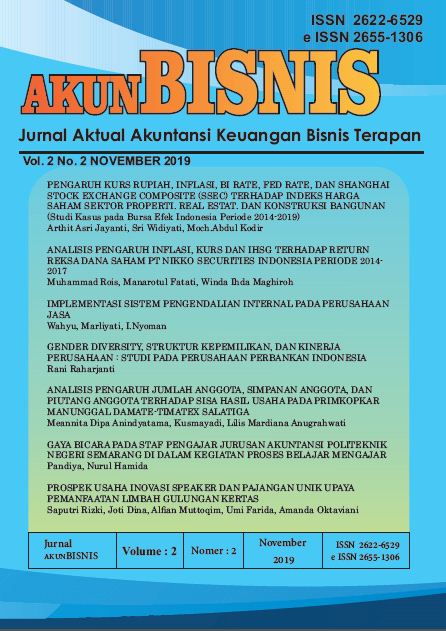PENGARUH KURS RUPIAH, INFLASI,BI RATE, FED RATE, DAN SHANGHAI STOCK EXCHANGE COMPOSITE (SSEC) TERHADAP INDEKS HARGA SAHAM SEKTOR PROPERTI, REAL ESTAT, DAN KONSTRUKSI BANGUNAN (Studi Kasus pada Bursa Efek IndonesiaPeriode 2014-2018)
Abstract
This research aims to analyze the influence of the rupiah exchange rate, inflation, BI rate, FED rate, and SSEC onThe Stock Price Index of Property, Real Estate and Building Constructionon Indonesia Stock Exchange during 2014-2018. This research used secondary data. The sampling methodused total sampling, so the sample is the entire population or all of companies listed in property, real estate, and building construction sector on Indonesia Stock Exchange during 2014-2018. The research statistical model used multiple linear regression analysis model processed by software SPSS 25. The equation of this regression model estimation on this research: IHSSP = 339.651 ”“ 0.019KU -837.814IN + 460.140BR + 141.072FR + 0.023IS + ℯ. The F testresult of this research show the rupiah exchange rate, inflation, the BI rate, the FED rate, and SSEChave significant simultaneously influence on the Sector Stock Price Index of Property, Real Estate, and Building Construction. Then the t test result of this research show the rupiah exchange rate has significant partially influence, so H1 was accepted. Inflation has significant partially influence, so H2 was accepted. BI rate has not significant partially influence, so that H3 was rejected. FED rate has not significant partially influence, so H4 was rejected. SSEC has significant partially influence, so H5 was accepted on the Sector Stock Price Index of Property, Real Estate, and Building Construction. The coefficient of determination is 0.826., so the ability variation of the independent variables (rupiah exchange rate, inflation, BI rate, FED rate, and SSEC) in explaining the variation of the dependent variable (Sector Stock Price Index of Property, Real Estate, and Building Construction) was 82.6%, while the rest was explained by other independet variable soutside this researchReferences
Akbar, Yogie Alan. 2016. “Pengaruh
Fundamental Makroekonomi dan
Indeks Negara Tujuan Ekspor
Indonesia terhadap Indeks Harga
Saham Gabungan (IHSG)”. Jurnal
Ilmiah Mahasiswa FEB
Universitas Brawijaya, Volume 4,
Nomor 2, Malang.
Artini, Luh Gede Sri et al. 2017.
“Analisis Fundamental Makro dan
Integrasi Pasar Saham Dunia
dengan Bursa Efek Indonesia”.
Jurnal Manajemen, Strategi Bisnis
dan Kewirausahaan Universitas
Udayana, Volume 11, Nomor 2,
Bali.
Bursa Efek Indonesia.2010. Buku
Panduan Indeks Harga Saham
Gabungan Bursa Efek. Indonesia.
Jakarta: Indonesia Stock
Exchange. Bursa Efek Indonesia.
Cahya, Putu Fenta Pramudya et al.
“Indeks Harga Saham Sektor
Properti dan Real Estate yang
Tercatat di Bursa Efek Indonesia
Tahun 2011-2013”. E-Journal
Bisma Universitas Pendidikan
Ganesha, Volume 3, Nomor (1).
Christa, Ruth dan Wahyu Ario
Pratomo. 2013. “Analisis Pengaruh
Indeks Harga Saham di Bursa
Global terhadap Indeks Harga
Saham Gabungan di BEI”. Jurnal
Ekonomi dan Keuangan
Universitas Sumatera Utara,
Volume 1, Nomor 8, Medan.
Ghozali, Imam. 2014. Ekonometrika:
Teori dan Aplikasi dengan IBM
SPSS 24. Semarang: Badan
Penerbit Universitas Diponegoro.
Ilham, Andry. 2013. “Analisis
Pengaruh Variabel Makro Ekonomi
terhadap Indeks Harga Saham
Sektoral pada Bursa Efek
Indonesia”. Tesis Universitas Gajah
Mada, Yogyakarta.
Lukisto, Johnson dan Njo Anastasia.
“Dampak Makroekonomi
terhadap Indeks Harga Saham
Sektor Properti di Indonesia
Periode Tahun 1994-2012”. Jurnal
Analisa Universitas Kristen Petra,
Volume 3, Nomor 2, Surabaya.
Manihuruk, Orientasi Peratun dan Ari
Darmawan. 2017. “Pengaruh BI
Rate, FED Rate dan Kurs Rupiah
terhadap Indeks Harga Saham
Gabungan (IHSG) (Studi pada
Bursa Efek Indonesia Periode 2009-
”. Jurnal Administrasi Bisnis
Universitas Brawijaya, Volume 52,
Nomor 2, Malang.
Mardiyati, Umi dan Ayi Rosalina.
“Analisis Pengaruh Nilai
Tukar, Tingkat Suku Bunga dan
Inflasi terhadap Indeks Harga
Saham Studi Kasus pada
Perusahaan Properti yang
Terdaftar di Bursa Efek Indonesia”.
Jurnal Riset Manajemen Sains
Indonesia Universitas Negeri
Jakarta, Volume 4, Nomor 1,
Jakarta.
Misgiyanti dan Idah Zuhroh. 2009.
“Pengaruh Suku Bunga Luar
Negeri Federal Reserve (The FED ),
Nilai Tukar Rupiah/ US $ dan
Inflasi terhadap Indeks Harga
Saham Gabungan di Bursa Efek
Indonesia Periode 2006-2008”.
Jurnal Ekonomi Pembangunan
Universitas Muhammadiyah
Malang, Volume 7, Nomor 1,
Malang.
Prastyo, Eko. 2015. Ternyata
penelitian itu mudah. Lumajang:
EduNomi.
Purwanto, Erwan Agus dan Dyah
Ratih Sulistyastuti. Metode
Penelitian Kuantitatif untuk
Administrasi Publik dan Masalahmasalah Sosial. 2017. Yogyakarta:
Gava Media.
Rohmanda, Deny et al. 2014.
“Pengaruh Kurs Rupiah, Inflasi
dan BI Rate terhadap Harga
Saham (Studi pada Indeks Sektoral
Bursa Efek Indonesia Periode 2005-
”. Jurnal Administrasi Bisnis
Universitas Brawijaya, Volume 13,
Nomor 1, Malang.
Sofyani, Nurin Widyastuti dan Sugeng
Wahyudi. 2015. “Analisis Pengaruh
Variabel Makro Ekonomi Global
dan Makro Ekonomi Domestik
terhadap Indeks Harga Saham
Sektor Properti dan Real Estate
Dengan Metode GARCH (Periode
Januari 2004-Desember 2014)”.
Diponegoro Journal of Management
Universitas Diponegoro, Volume 5,
Nomor 1, Semarang.
Sugiyono. 2016. Statistika untuk
Penelitian.. Bandung: Alfabeta
www.bi.go.id
www.databoks.katadata.co.id
www.idx.co.id
www.Investopedia.com
wwww.Kemendag.go.id
www.Klikpajak.com
www.Properti.compas.co.id
www.wikipedia.co.id
Witjaksono, Ardian Agung. 2010.
“Analisis Pengaruh Tingkat Suku
Bunga SBI, Harga Minyak Dunia,
Harga Emas Dunia, Kurs Rupiah,
Indeks Nikkei 225, dan Indeks Dow
Jones terhadap IHSG”. Skripsi
Universitas Diponegoro, Semarang.
Zulkarnain, Ronny Wijaya. 2016.
“Faktor Fundamental Ekonomi
Makro terhadap Indeks Harga
Saham Properti”. Jurnal Aplikasi
Manajemen Universitas
Widyatama, Volume 14, Nomor 3,
Bandung.
Downloads
Published
Issue
Section
License
The copyright of the received article shall be assigned to the journal as the publisher of the journal. The intended copyright includes the right to publish the article in various forms (including reprints). The journal maintains the publishing rights to the published articles.

This work is licensed under a Creative Commons Attribution 4.0 International License.






